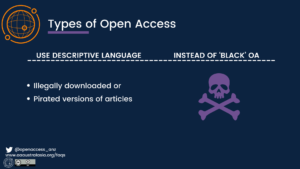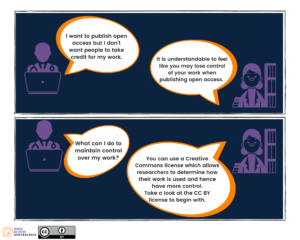
Open access (OA) is a set of principles and a range of practices through which research outputs are distributed online, free of cost or other access barriers. Through licensing via an open license (usually a Creative Commons License), freely available outputs can also be legally shared and reused. Hence, open access is more than just free access.
The original definitions of open access were first proposed in Budapest in 2002, Berlin in 2003 and Bethesda in 2003.
One definition is:
“For scholarly work, Open Access means making all scholarly outputs freely available via the Internet, permitting any user to read, download, copy, distribute, print, search, or link to the full text of these articles, crawl them for indexing, pass them as data to software, or use them for any lawful purpose, without financial, legal or technical barriers other than those inseparable from gaining access to the internet itself.”
Since then the technology and legal frameworks associated with open access have been refined, especially the need for associated open licenses.
Use and adapt this graphic:
Article Processing Charges (APCs) are fees charged by publishers to make articles in scholarly journals open access, specifically to cover the costs of publication and journal administration. These fees may be paid by an author’s institution or funding body or (more rarely) by an author themselves. APCs may also be included as part of transformative agreements. These fees range enormously in price and can can be in excess of AUD$10,000 per article – the highest APCs are usually for articles in “hybrid” open access journals. However, many scholarly journals, particularly those supported by universities, publish open access with no costs at all to researchers – these journals are known as “diamond” open access journals.
Transformative Agreements describe contracts negotiated between institutions (libraries, national and regional consortia) and publishers that aim to transform the business model underlying scholarly journal publishing, moving from one based on subscriptions to one in which publishers are remunerated a fair price for their open access publishing services. See Plan S FAQs. In Australasia, transformative agreements are negotiated by the Council of Australian University Librarians.
Use and adapt this graphic:
Direct Link
Repository-based or “Green” open access
“Green” open access is the term used when the author accepted version of a published work is deposited into a subject-based repository or an institutional repository. Every university in Australia has a repository for this purpose. International examples include PubMed Central® (PMC) and Europe PMC. Articles may have a Creative Commons License applied, which specifies how the article can be used
Journal-based or “Gold” Open Access
“Gold” open access refers to publishing in a fully open access scholarly journal, one where the publisher of the journal provides free and immediate online access to the full content of the journal and the final published versions of articles in that journal are fully open access. Articles have a Creative Commons License applied, which specifies how the article can be used. Business models for this form of open access vary. In some cases, the publisher charges an article processing charge (APC), which may be paid by the author’s institution or funding body or by an individual researcher. APCs may also be paid as paid of transformative agreements. A comprehensive list of open access journals is maintained by the Directory of Open Access Journals. There is also a Directory of Open Access Books.
“Diamond” Open access
“Diamond” open access refers to open access journals that are free for readers to access and for authors to publish in. These journals are often community-driven and supported by institutions or by national or regional infrastructure. A recent report commissioned by cOAlition S explored the huge global range of Diamond open access journals.
“Hybrid” open access
“Hybrid” open access refers to when an article processing charge is paid for an individual journal article to be made open access in an otherwise subscription journal. This type of open access always has an APC associated with it and these APCs are usually higher than for fully open access journals . Hybrid open access is not supported by any universities in Australia and New Zealand, other than through “read and publish agreements” where universities pay for both access to research and for academics to publish in specific journals.
“Bronze” open access
“Bronze” open access refers to a freely available journal article that has no open license (and hence cannot be considered fully open access).
“Black” open access
“Black” open access refers to illegal open access.
Further reading: this article discusses the frequency of all the various types of open access.
Use and adapt these graphics:
Here are some suggestions for resources on converting journals from subscription based to open access.
This graphic neatly illustrates the many benefits of open access.
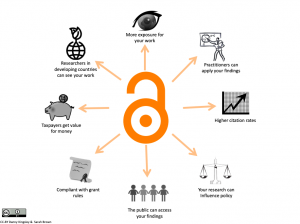
This paper “The academic, economic and societal impacts of Open Access: an evidence-based review” discusses the the academic, economic and societal impacts of Open Access
The citation advantage for open access papers was analysed in this paper from 2018.
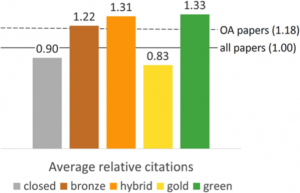
Piwowar H, Priem J, Larivière V, Alperin JP, Matthias L, Norlander B, Farley A, West J, Haustein S. 2018. The state of OA: a large-scale analysis of the prevalence and impact of Open Access articles. PeerJ 6:e4375 https://doi.org/10.7717/peerj.4375
Open access papers also have more downloads compared with non-open access papers.
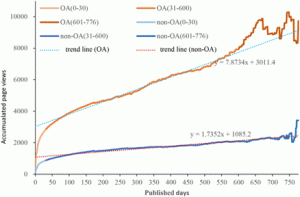
Comparison of accumulation page view between OA and non-OA articles Wang, X., Liu, C., Mao, W. et al. Scientometrics (2015) 103: 555. https://doi.org/10.1007/s11192-015-1547-0
Open access books also have more citations, downloads and usage than non open access books.
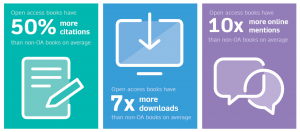
Springer Nature white paper The OA effect: How does open access affect the usage of scholarly books? November 2017.
https://www.springernature.com/gp/open-research/journals-books/books/the-oa-effect
As defined on the Creative Commons (CC) website: Creative Commons licences give everyone from individual creators to large institutions a standardized way to grant the public permission to use their creative work under copyright law. From the re-user’s perspective, the presence of a Creative Commons licence on a copyrighted work answers the question – “What can I do with this work?”
There are six CC licences. For help deciding which to use, use the Creative Commons License Chooser.
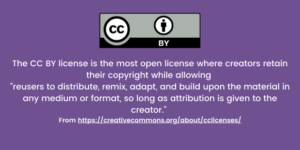
Use and adapt these graphics:
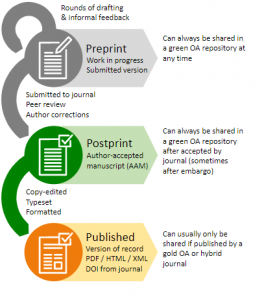
Typical publishing workflow for an academic journal article (preprint, postprint, and published) with open access sharing rights per SHERPA/RoMEO.
Thomas Shafee – Own work; adapted from diagram by Ginny Barbour CC BY 4.0
Author’s Original/Preprint is the version of the article before peer review or editing, as submitted by an author to the journal. It is also the version submitted to a preprint server.
Accepted Manuscript (AAM) or “Postprint” is ‘the version of the article accepted for publication including all changes made as a result of the peer review process, but excluding any editing, typesetting or other changes made by journal or publisher.
Final Published Version/Version of Record is the peer reviewed, edited, formatted and typeset version of the article, including any tagging, indexing and other enhancements from a publisher. It includes any post publication corrections made by a publisher. CrossCheck maintains a system which can check for Versions of Record on published articles.

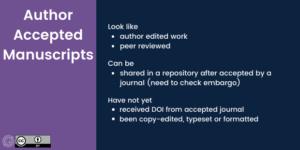
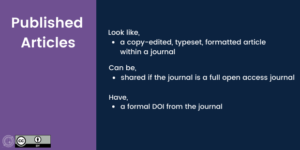
Use and adapt these graphics:
Just as with selecting any journal, do your research. Ask peers and colleagues if they have experience with this publisher. Check which databases the journal is indexed in. Don’t engage with emails sent by people claiming to be publishers. Work through Think Check Submit so you feel more confident in your decision and check the Directory of Open Access Journals (DOAJ). Don’t reply on “blacklists” of predatory journals. These list are often subjective and may be out of date
DOAJ is the Directory of Open Access Journals.
This is a community-curated online directory that indexes and provides access to high quality, open access, peer-reviewed journals.








